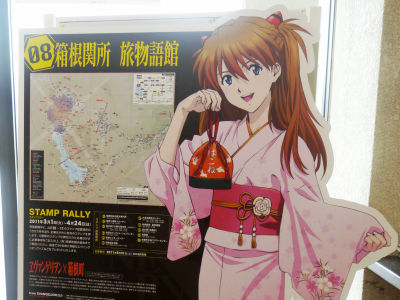I participated in the Tenryu Hamanako Railway and Enshu Railway's 'Humanity Ride Plan 2025' where I could ride an Evangelion-wrapped train and collect stamps

Starting in April 2025, the ' Shin Hamamatsu Project ', a collaborative project with Evangelion, will be held to commemorate the 20th anniversary of the merger of Hamamatsu City, Shizuoka Prefecture, and 11 surrounding municipalities. As part of this project, a stamp rally entitled ' Humanity Ride Plan ' is being held to collect all 10 stamps set up at 20 locations in Hamamatsu City (and some outside the city), so I used a free ticket to go around the rally points located around Lake Hamana.
Shin Hamamatsu Plan 2025
There are 10 types of stamps in total, and 20 locations, so there are some duplicates at some facilities. The '2025 Human Ride Plan Hamamatsu Supplementary MAP' shows where each stamp is located, so if you check it in advance, you won't miss any stamps.
2025 Humanity Ride Plan Hamamatsu Supplementary MAP
(PDF file) https://shin-hamamatsu-keikaku2025.jp/assets/pdf/map2025.pdf
This time, we will start from Kakegawa Station in Kakegawa City. This is on the south side of Kakegawa Station, which has a long, horizontal appearance typical of a Shinkansen station.

Since I want to board
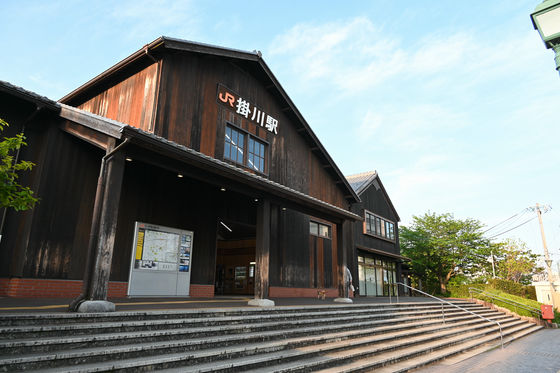
To the west of there is Kakegawa Station on the Tenhama Line.
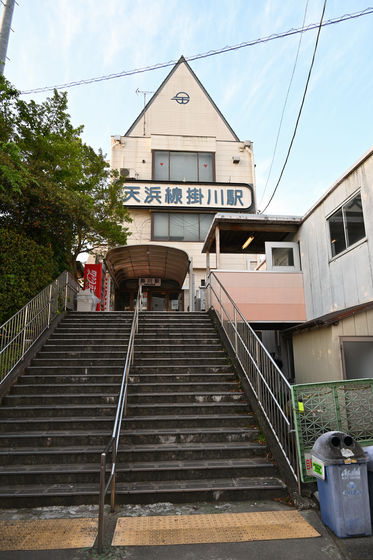
At the stamp locations, stamps and stand panels are set up like this. '09 Kakegawa Station' was a panel of Kensuke Aida.
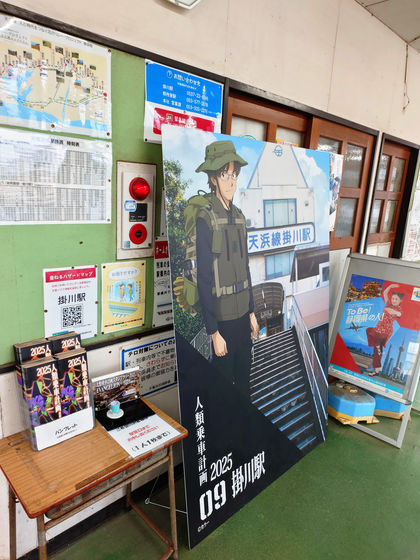
The stamp paper looks like this.

From here, I will be using the Tenryu Hamanako Railway and the Enshu Railway to collect stamps, so I bought a one-day pass that can be used on both lines. In line with the 'Shin Hamamatsu Project,' the ticket that can be used on the Enshu Railway and the west side of the Tenryu Hamanako Railway features Ikari Shinji, and the ticket that can be used on the Enshu Railway and the east side of the Tenryu Hamanako Railway features Nagisa Kaworu.
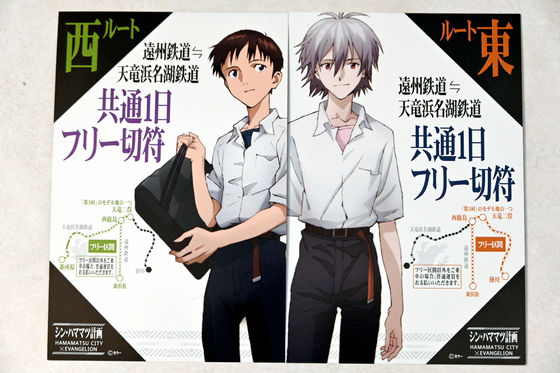
The timetable for Kakegawa Station looks like this, with the first train leaving at 6:30am and approximately one or two trains per hour.
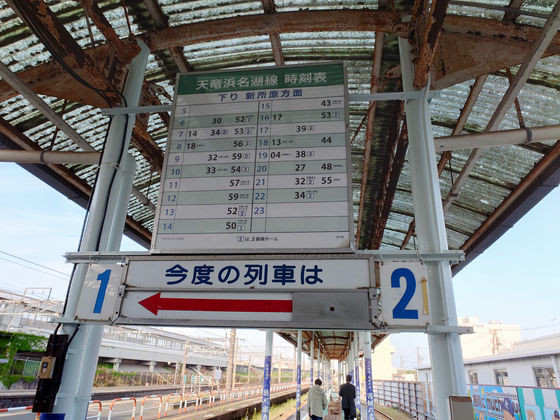
Tenryu Hamanako Railway has many wrapped trains, and this time it was the 'KATANA' train, which is based on a Suzuki motorcycle.

The wrapping also covered the side windows, making it a little difficult to see out the windows.
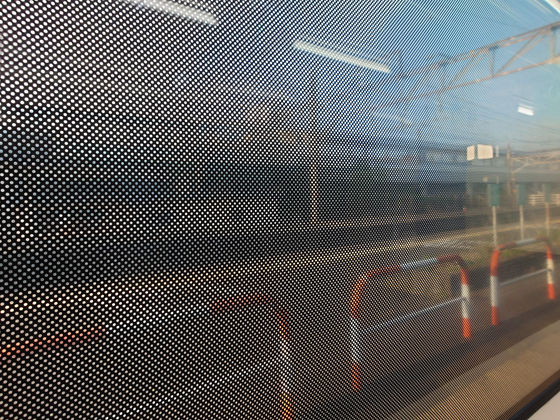
I decided to tackle the eastern route first, but since it took a while for the nearby stamp facility to open, I decided to go to the photo spot at Enshu Railway's Saginomiya Station first. To get to Enshu Railway, you need to transfer at Nishikashima Station.

You can travel from the Tenryu Hamanako Railway platform to the Enshu Railway platform via an underground passage.
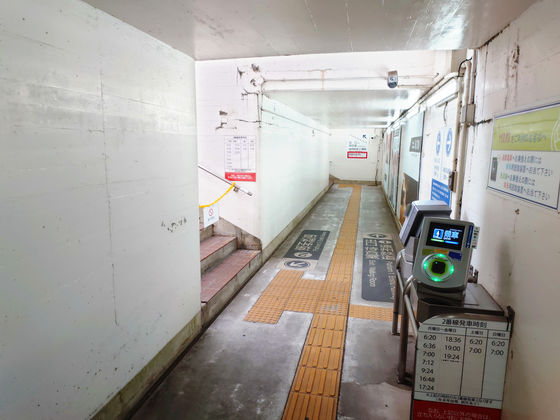
A 'Humanity Ride Plan' panel installed in the underground passage.
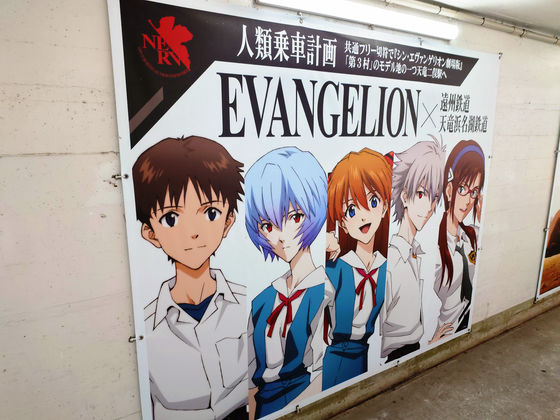
Mari's panel providing information about the Enshu Railway's 'Shin Hamamatsu' line.
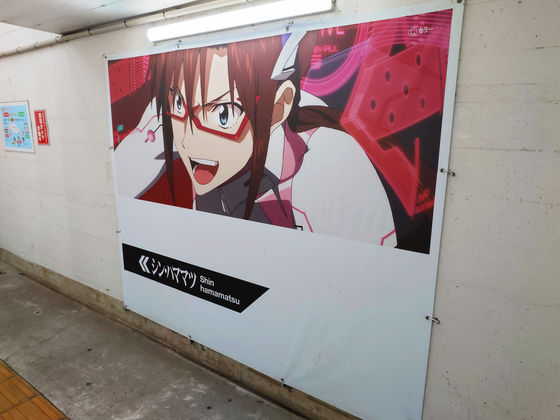
There was also a panel of Toji and Rei, as one of the locations used as a model for the 'Third Village' that appeared in the movie was Tenryu-Futamata Station on the Tenryu Hamanako Railway.

Travel in a colorful Enshu Railway carriage.
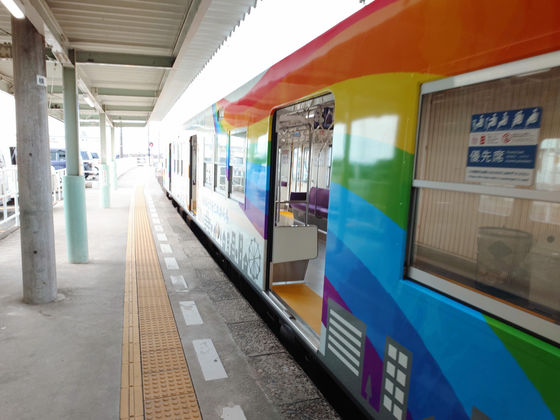
As we left Nishikashima Station, we spotted an Eva-wrapped vehicle in the depot.

Arrived at Saginomiya Station. There is a panel of Gendo Ikari for '21 Saginomiya Station' on the bench. There is no stamp.
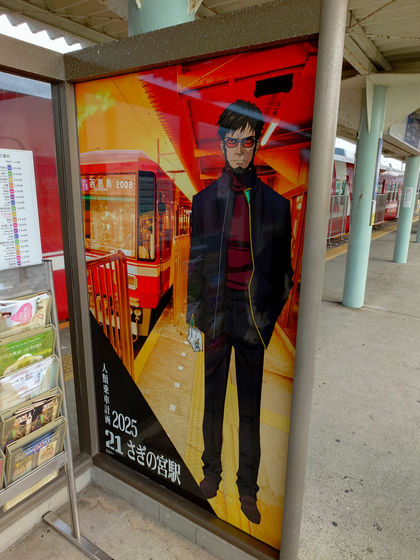
Saginomiya Station is said to be the motif for the urban legend 'Kirasagi Station.'

After checking on Gendo, we headed back to Nishikashima, and this time we saw the Tenryu Hamanako Railway's Evangelion-wrapped train. It was based on the purple of Unit 01, so it was very noticeable even from a distance.
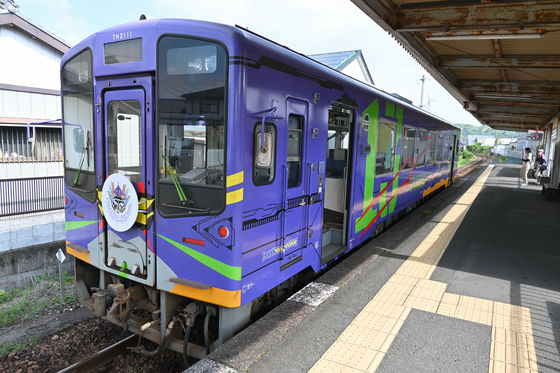
The interior of the vehicle is also wrapped.
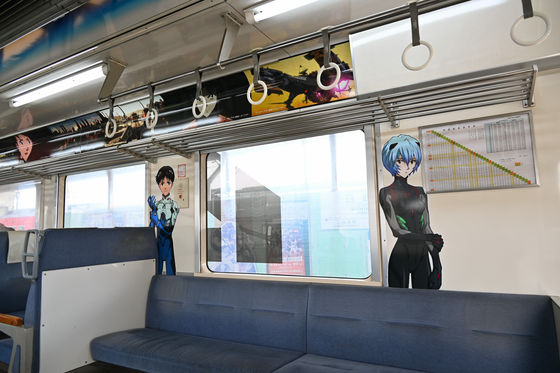
We cross the Tenryu River and head for Tenryu-futamatata Station.
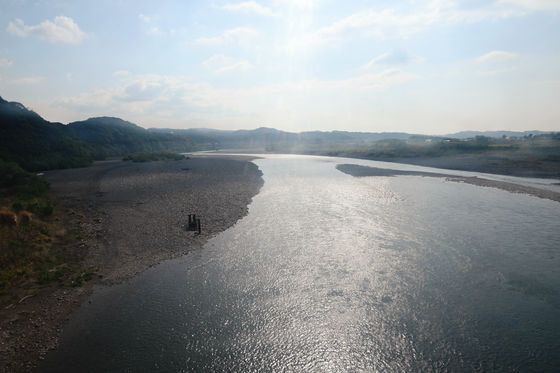
We have arrived at Village 3.
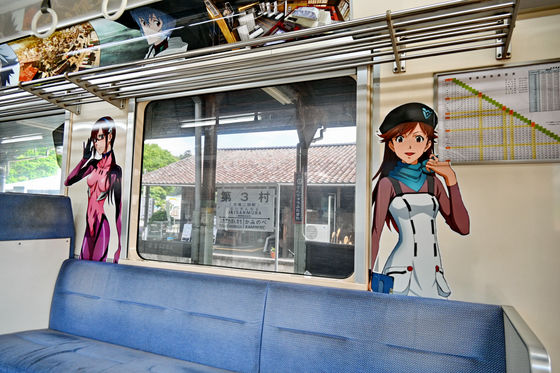
Since Tenryu-futamata Station is one of the models for the third village, the station name sign has been changed for a limited time.

Inside the station building there is a panel of Ikari Shinji with the words '01 Tenryu-futamata Station' written on it.
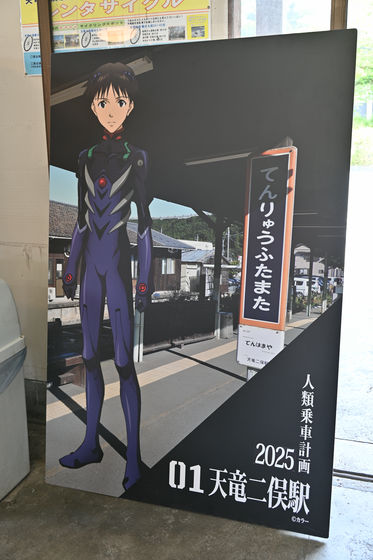
I thought there was a stamp there, but it was actually a stamp for '88 Anime Holy Sites in Japan You Should Visit.'

You can only get your stamp for the stamp rally when the shop is open from 9:00am to 4:00pm, so you will have to wait for the shop to open.
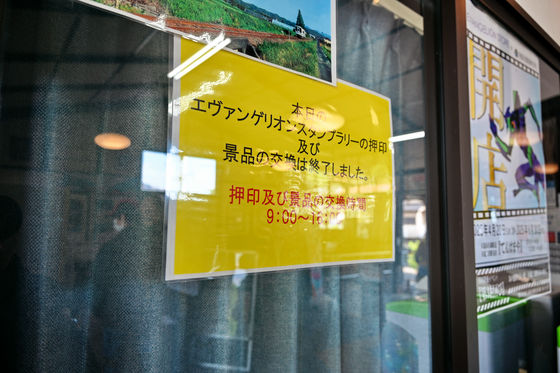
Once we left the station, we noticed not only Eva but also 'Laid-Back Camp' elements.
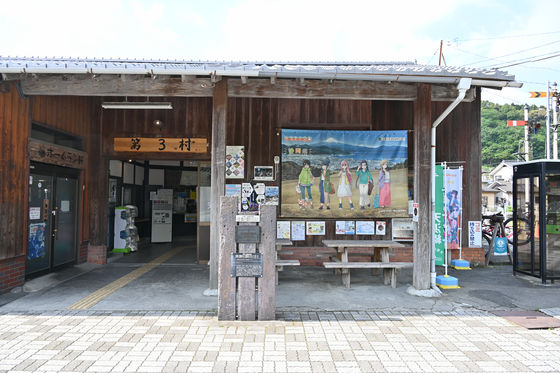
I wanted to go to the turntable tour because there is a stamp there, but the ticket sales start about 30 minutes before the tour starts, so I decided to put it off. First, I decided to head to
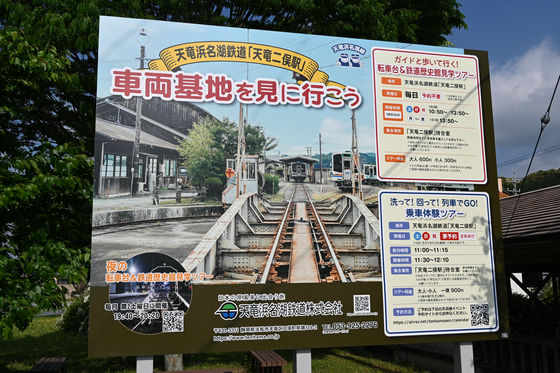
I discovered Locomotive Park across the road from Tenryu-Futamata Station, so I decided to take a little detour.
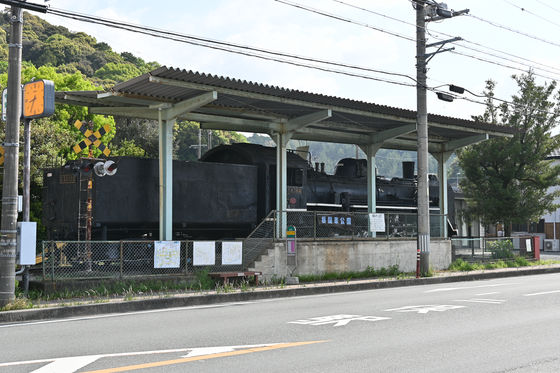
C58 389 was on display.
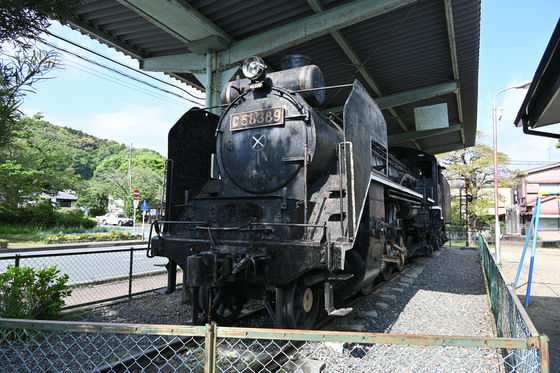
We walked towards the museum. As we walked along the road on the east bank of the river, we came across the remains of an unfinished railway tunnel in the mountains.
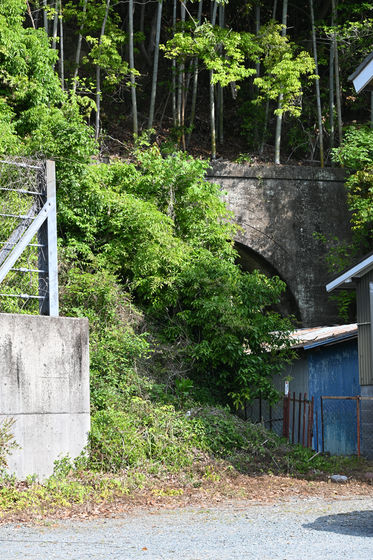
Once you arrive at the museum entrance, head up the hill.
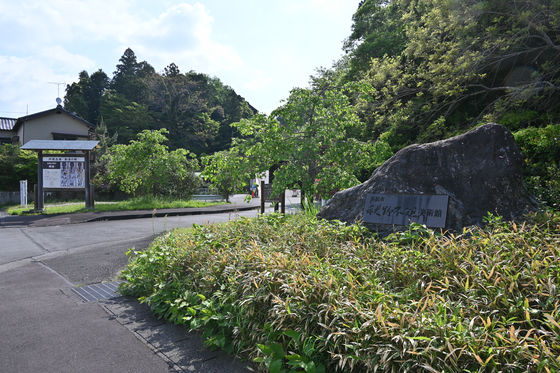
At the top of the winding hill is the Hamamatsu City Akino Fuku Art Museum. Opening hours are from 9:30 to 17:00, and admission is 310 yen for adults. However, since I had a 1-day free pass, I got a discount and paid 240 yen.
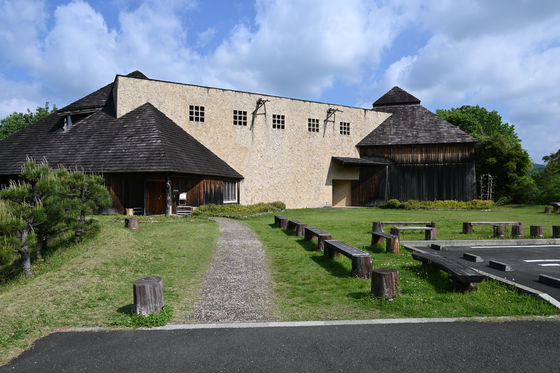
The stamp pad is located right after you enter.
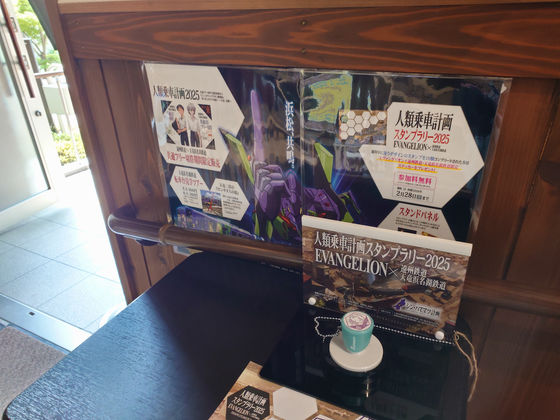
Vice Commander Fuyutsuki panel at '15 Akino Fuku Art Museum.'
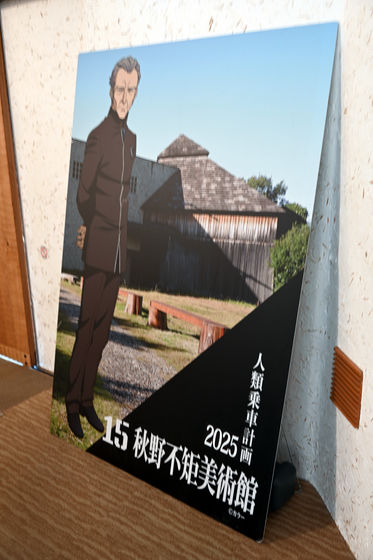
Please note that photography is prohibited inside the museum exhibition rooms. In the exhibition room at the back, you can get up close and personal with a huge painting measuring about 2 meters on each side.

If you go down the mountain where the museum is located and head west, you will find the
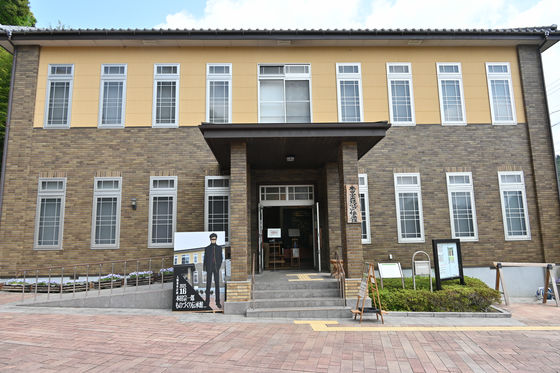
The '16 Soichiro Honda Manufacturing Heritage Museum' panel was set up outside the building. The stamp pad is located right after you enter the building.
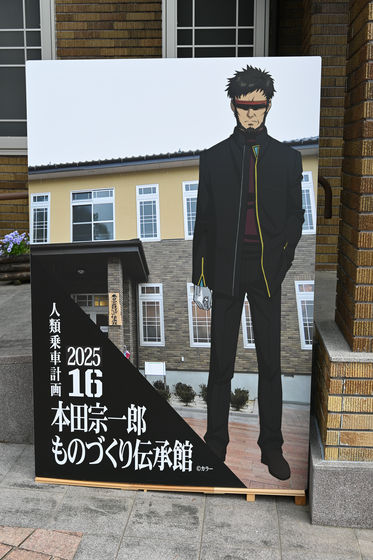
A variety of original goods are also sold.

Inside the museum, there are displays of Honda motorcycles from various generations. This is Honda's first motorbike, the Honda C-Type, which was released in 1949.

Since its introduction in 1958, the Super Cub has been produced in excess of 100 million units while retaining the same basic design.
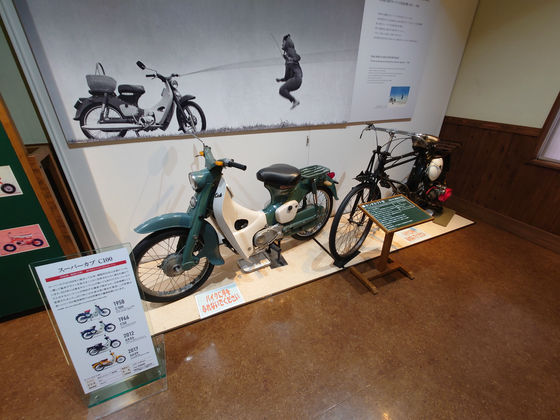
'ASIMO' is a humanoid robot released in 2000.
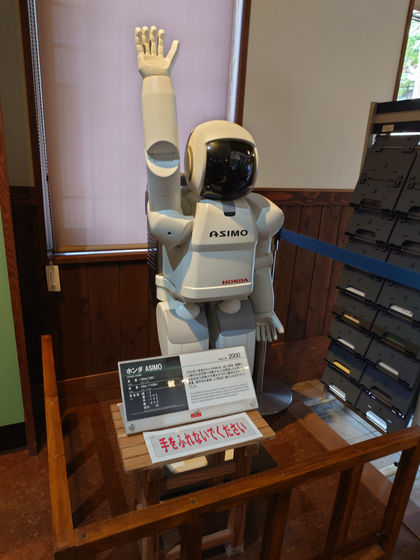
After collecting the stamps, I returned to the station and found the convenience store open.
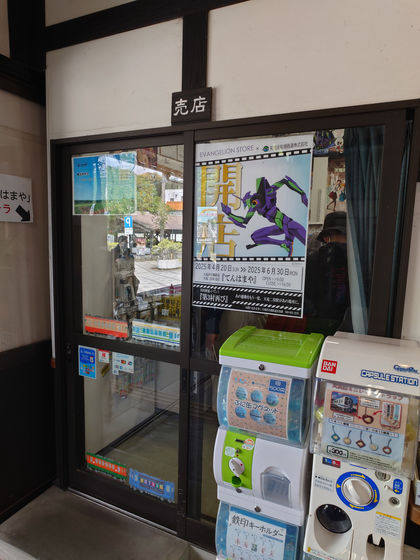
Then you will take part in a turntable tour where you will receive a stamp exclusive to participants. Each tour lasts about 40 minutes and costs 600 yen for adults and 300 yen for children. It is held twice a day, from 13:50 on weekdays and from 10:50 and 13:50 on weekends and holidays. No prior reservation is required, just purchase a participation ticket at the station on the day.
The tour will take you through passageways that are off-limits to anyone other than authorized personnel.
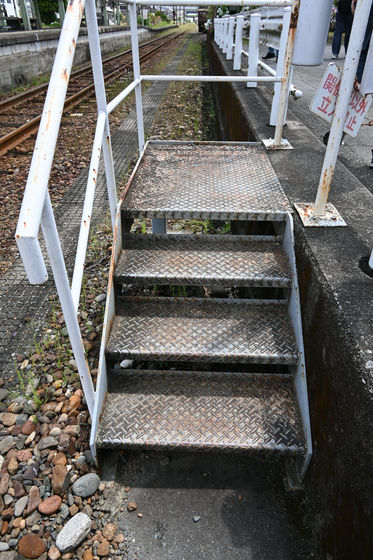
Huge water tower.
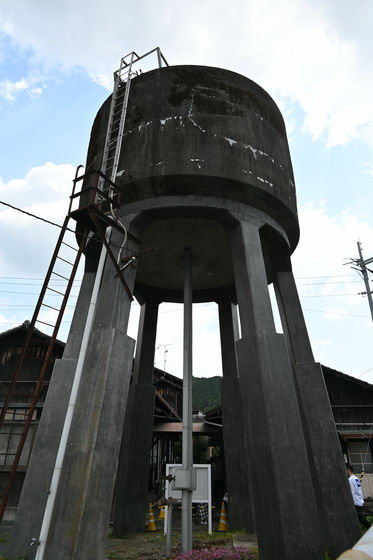
The bathhouse where engineers once washed has now been converted into a headmark exhibition area.

Arrived at the turntable.
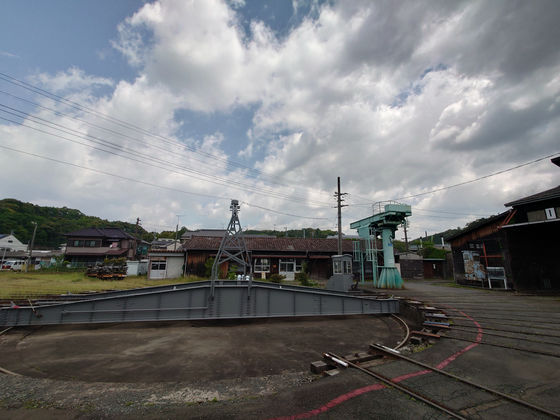
The Spear of Longinus was stuck in one corner.
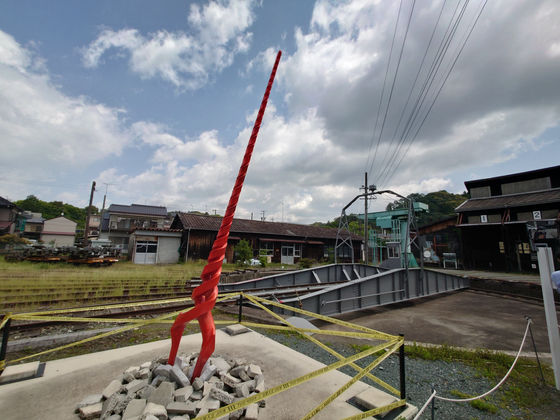
The correct position to view it is from, with the spear on the left side of the turntable.
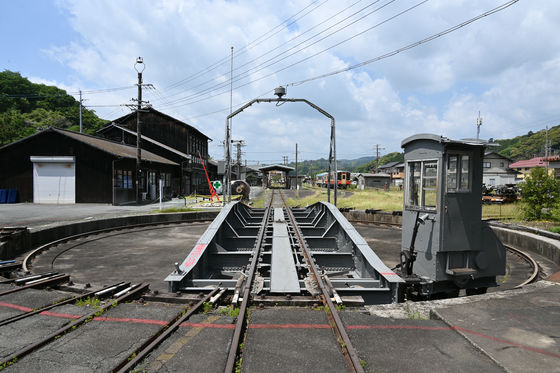
One of the buildings was the model for Toji Suzuhara's home in the film 'Evangelion: 3.0+1.0 Thrice Upon a Time.'
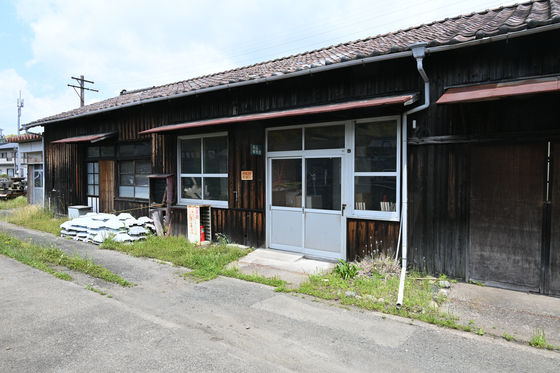
In the story, the roundhouse was used as a clinic.
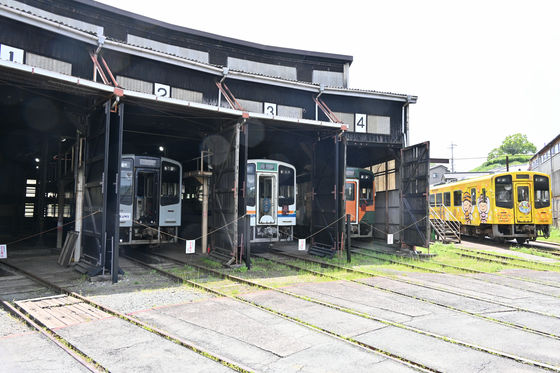
Collaboration panels were also on display in the reference room, which can only be accessed by tour participants.
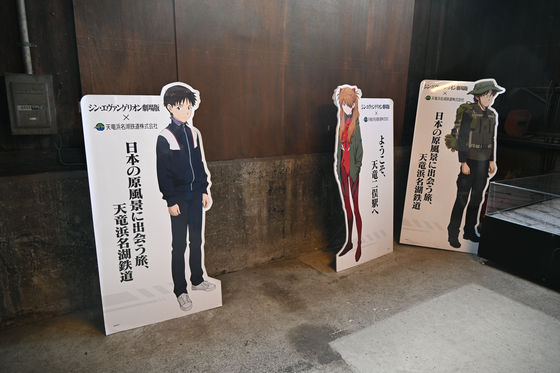
Ray dressed for farm work.

There are also panels explaining how Tenryu-futamata was the model for the 'Third Village.'
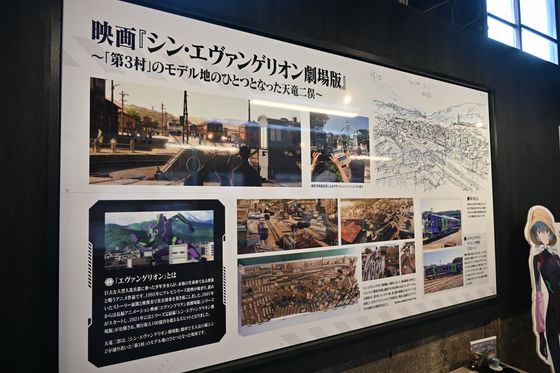
The '04 Turntable' stand panel is located near the entrance.
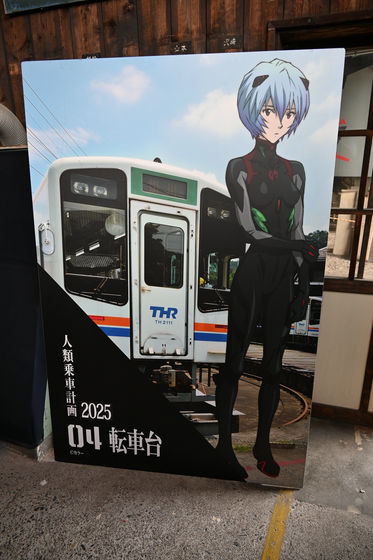
In the back, there was also a stand panel in collaboration with 'Yuru Camp△'.

Tenryu Hamanako Railway has also collaborated with other companies, so station signs from the past are also on display. This one is from a collaboration with the TV Tokyo program 'AKB48, have you heard recently? - Would you like to do something together? -'.
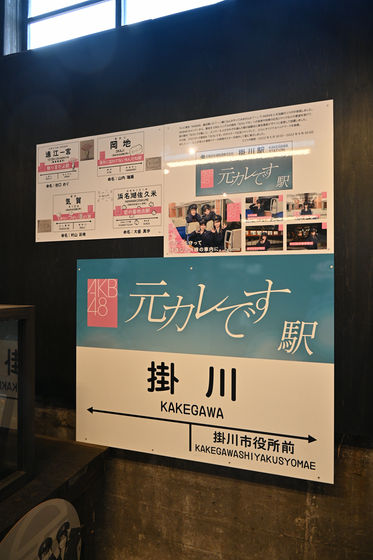
Because the station also has ties to Tokugawa Ieyasu, Tenryu-futamata Station was once given the secondary name 'Why!? Nobuyasu.'
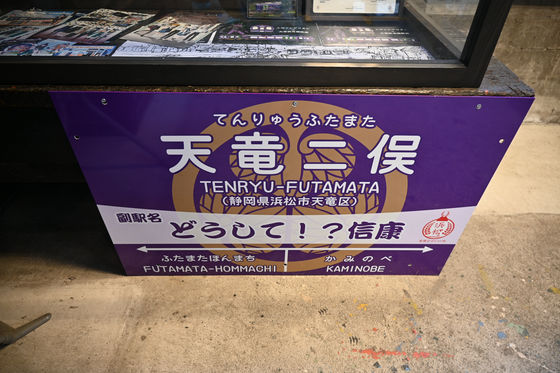
On the way back to the station, I saw a Yuru Camp△ wrapped train parked there.

When I went back to Nishi-Kashima Station, I spotted the Enshu Railway Evangelion-wrapped train that had been in the depot that morning, standing nearby. Unfortunately, it was not in service that day, so I was unable to ride it.
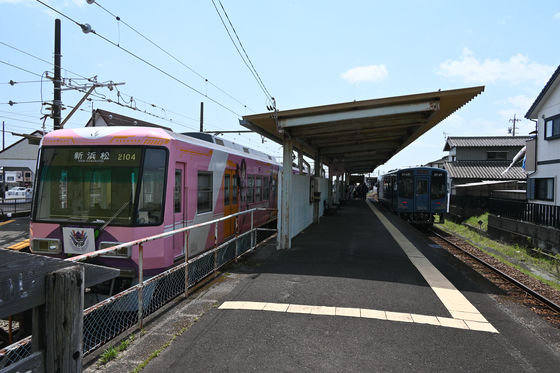
A Katsuragi Misato panel for '05 Nishikashima Station' inside the Nishikashima Station building.
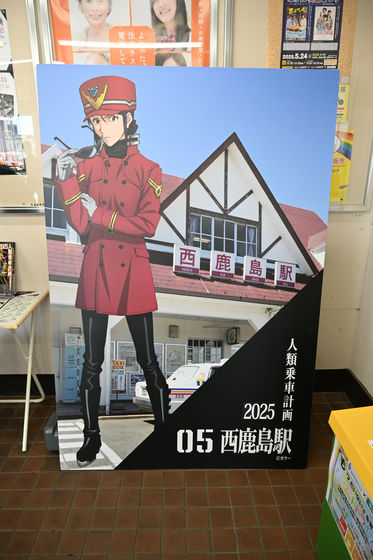
The exterior of Nishikashima Station looks like this.
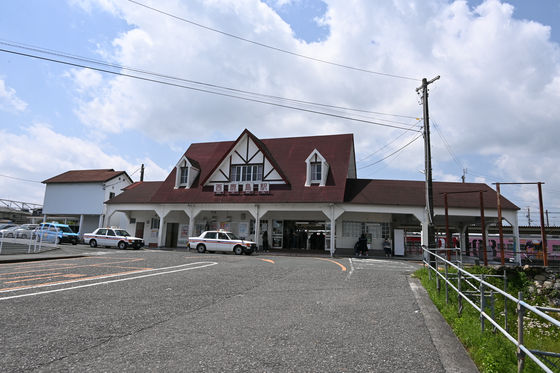
The train was also visible from outside the station. It was painted red with the No. 2 carriage and pink with the No. 8 carriage.
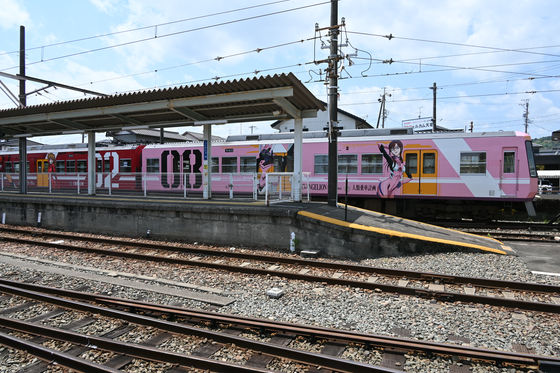
While I was doing this, a train to Shin-Hamamatsu arrived, so I boarded it and headed to Hamamatsu city center.

Instead of going all the way to Shin-Hamamatsu Station, I got off at Enshu Hospital Station along the way.

From here, you will travel on foot.
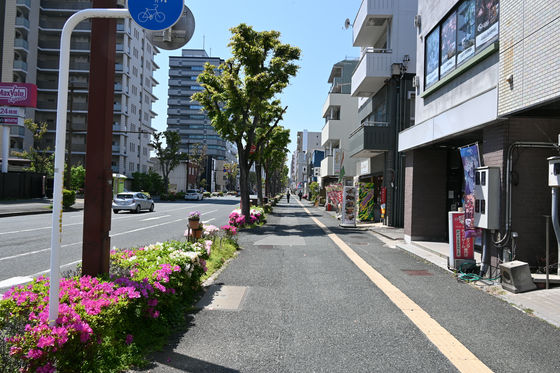
You can see the Evangelion Unit-01 statue at Hamamatsu City Hall.

Behind Hamamatsu City Hall is Hamamatsu Castle.
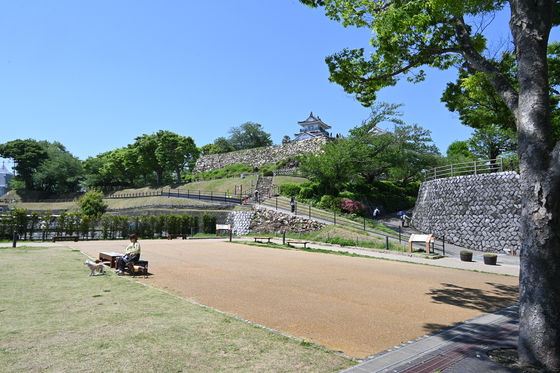
Before going to the castle tower, head to the Tenshumon Gate. You will need to take off your shoes, but entry is free (free).
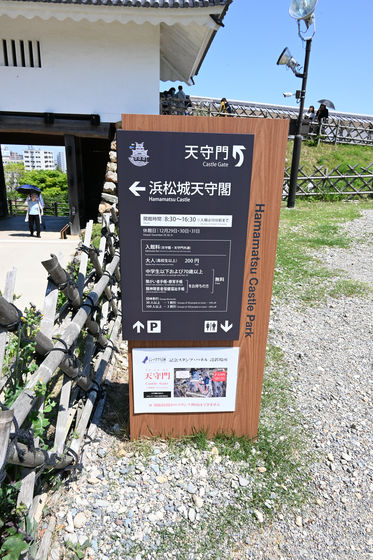
Inside the castle gate, there is a panel and stamp of Evangelion Unit 2 for '06 Hamamatsu Castle'. The stamp has the same design as the one at Kakegawa Station, so from this point on, I decided to 'see as many stand panels as possible, since I knew I had all the stamps.'
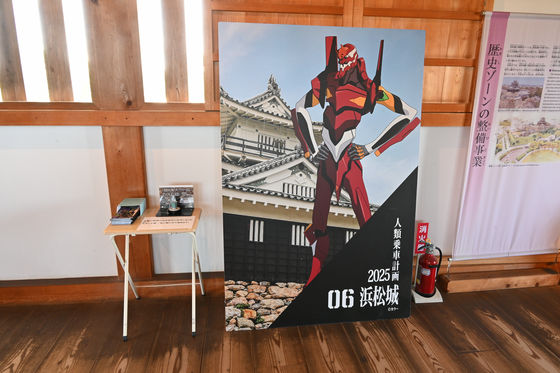
The castle tower of Hamamatsu Castle seen from the castle gate. Admission is 200 yen for adults.

This is a view to the southeast from the top floor of the castle tower, the large grey building on the left is Hamamatsu City Hall, and the tall building in the rear left is the 212.77m-tall Hamamatsu Act Tower.
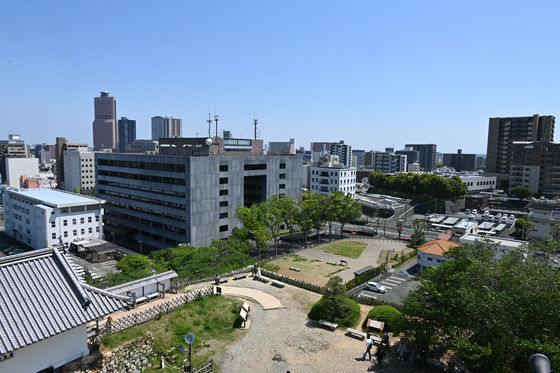
I walked back to Enshu Hospital Station again and took the Enshu Railway again to Shin-Hamamatsu Station.
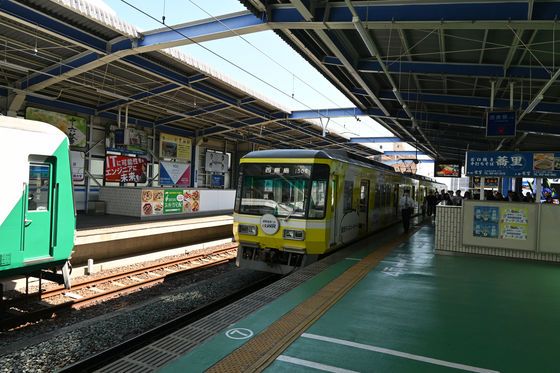
As you exit the station ticket gates, there is a waiting area on the left where you can see an Asuka panel for '02 Shin-Hamamatsu Station.'

We walked to Hamamatsu Station Bus Terminal, which has a distinctive circular structure.
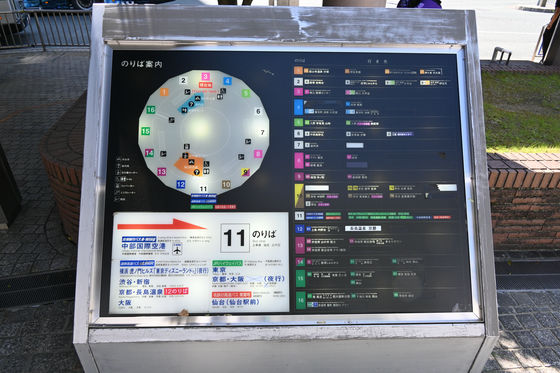
Inside the information center, there is an Evangelion Unit 8 panel from '03 Hamamatsu Station Bus Terminal.'
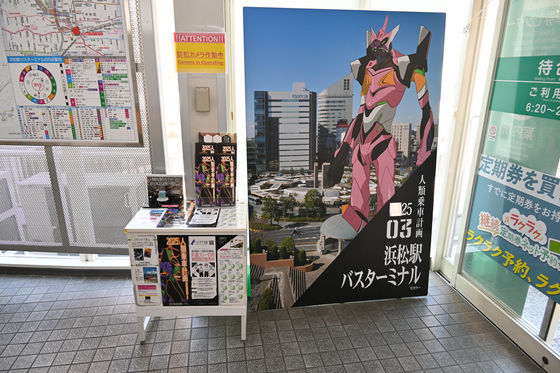
Additionally, the Hamamatsu City Tourist Information Center is located inside JR Hamamatsu Station.
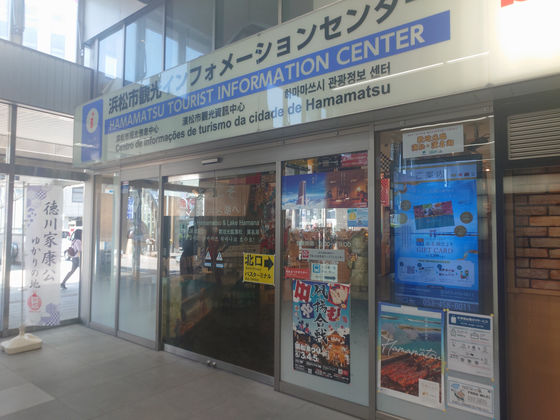
There is an Asuka panel for '08 Hamamatsu City Tourist Information Center' installed here.
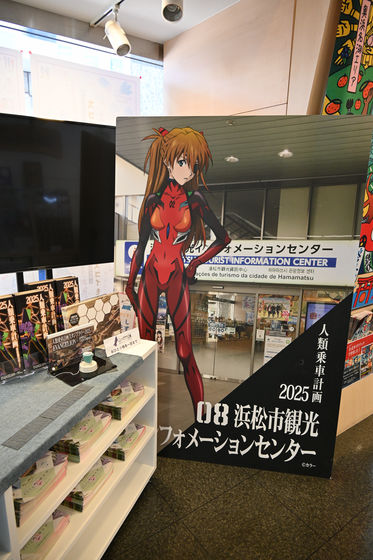
Located less than a 10-minute walk from the station is the
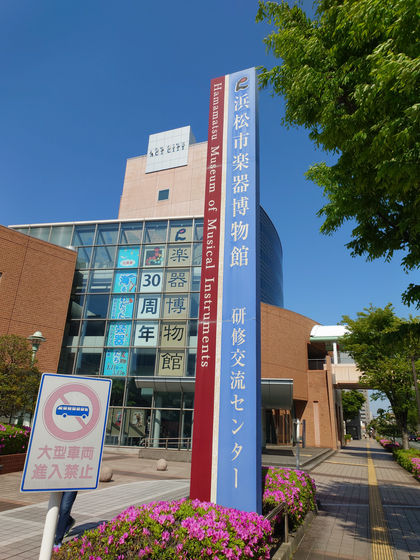
The use of flash, tripods, and selfie sticks is prohibited, but photography itself is OK.
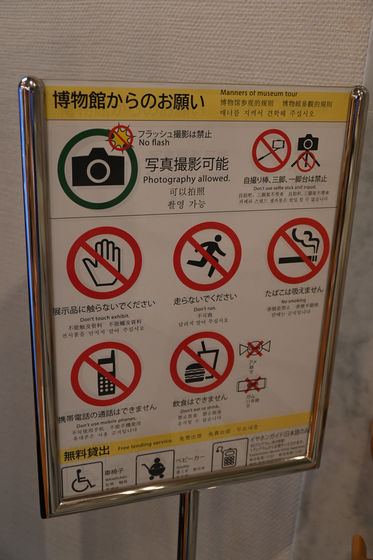
Although touching is prohibited, there are many musical instruments on display.
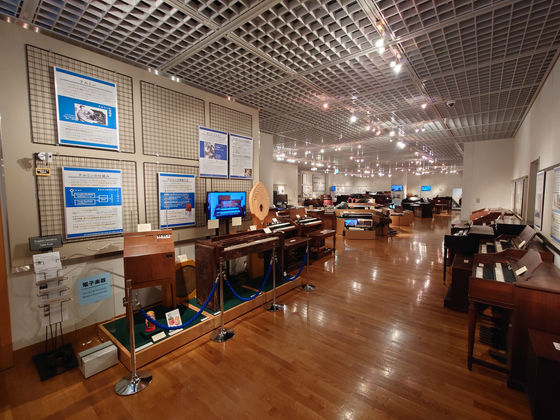
Next to the piano there is a panel of Nagisa Kaworu from the '07 Hamamatsu City Museum of Musical Instruments.'

The stamp is located near the elevator on the first floor.
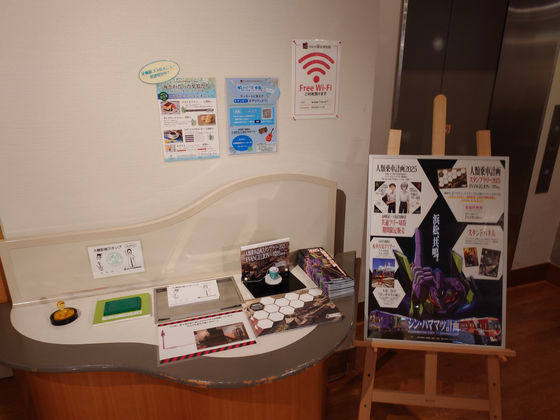
On the second day, we restarted our journey from Daiichi Dori Station on the Enshu Railway.
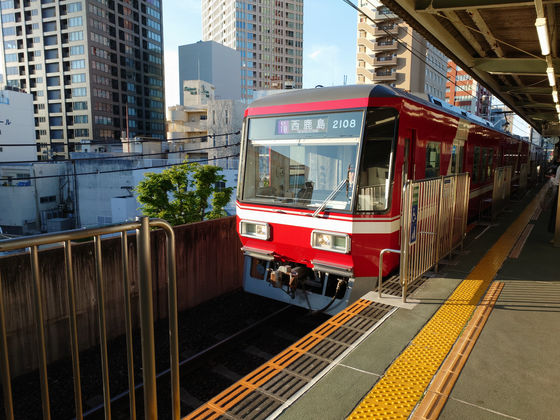
On this day, the wrapped train was parked at platform 2 at Nishikashima Station.

The second unit looks like this.
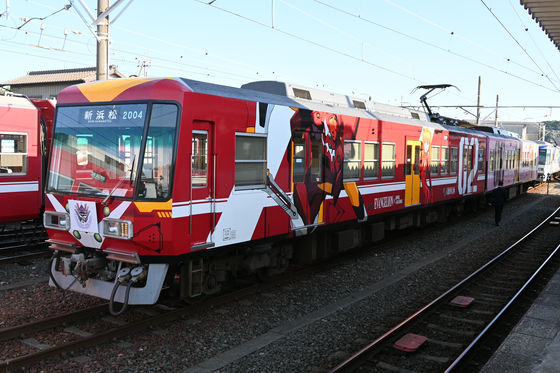
I would have liked to ride it, but since I was heading west on the Tenryu Hamanako Railway that day, I decided to just look at it.
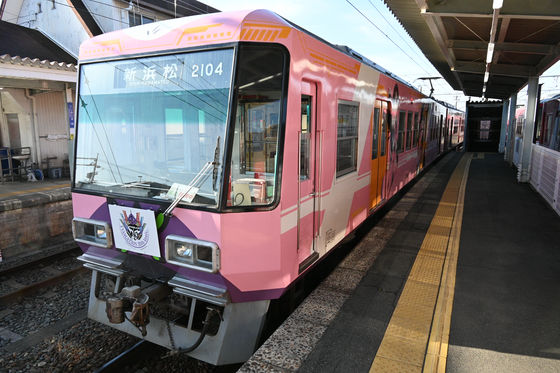
The interior of the car was standard.
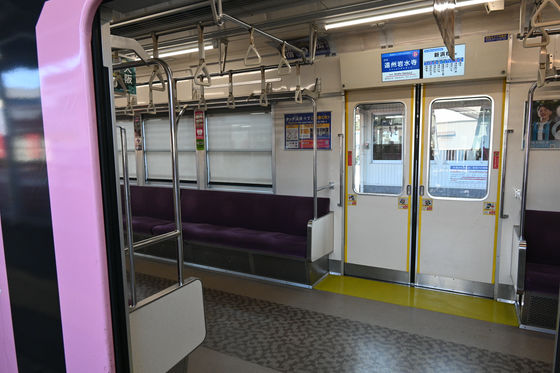
The Tenryu Hamanako Railway train heading towards Shinjohara is again an Evangelion-wrapped train.
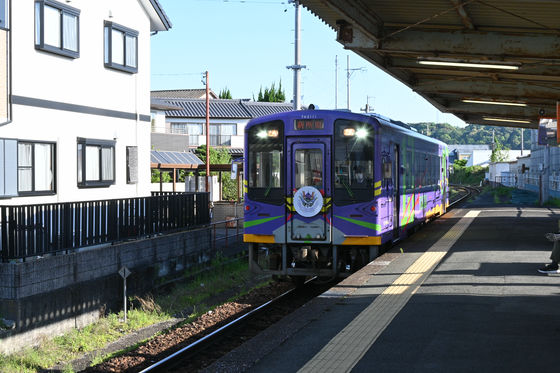
The Tenryu Hamanako Railway's daytime timetable from Tenryu Futamata westwards is exactly 'one train per hour.' Since going around in order would be a big waste, on this day I made a zigzag route. First, I went to Hamanako Sakume Station and got off. This station is right next to Lake Hamana, and one of the attractions is the birds that land along the tracks and fly up as if they are crossing in front of the departing train, but there were fewer birds in the morning.

After the train left, the birds returned.
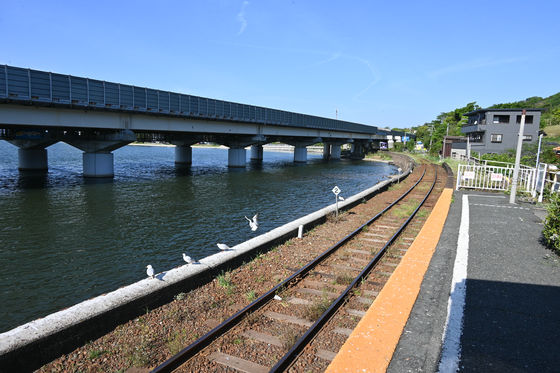
Inside the station building, there is a panel of Sakura Suzuhara at '11 Hamanako Sakume Station.' The 'Yuru Camp△' tapestry also stands out.

The exterior of the station looks like this. The building on the right that looks like a squatting cow is the public toilet.
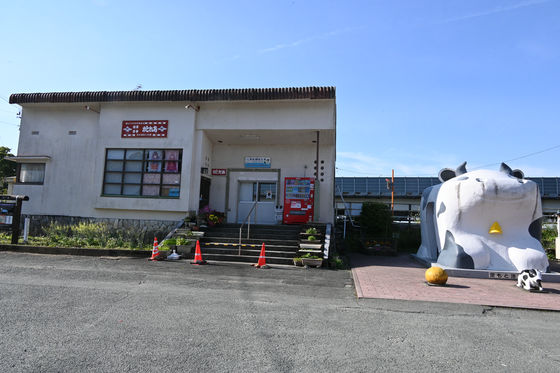
There is a coffee shop called 'Katorea' inside the station building, but I was not able to visit during opening hours this time.
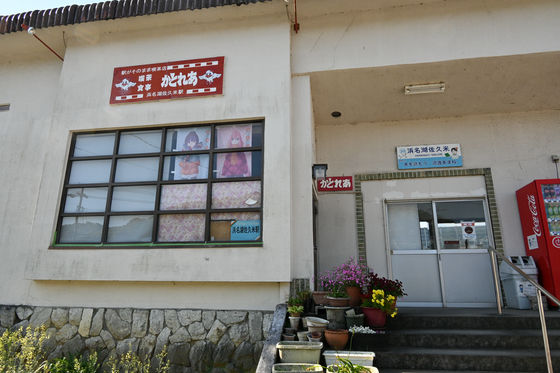
The Yurucamp△ wrapped train arrived on the return journey to the east. This is the train stopped at Mikkabi Station to allow the up and down trains to switch. While riding the Yurucamp△ wrapped train, I saw riders stopping their bikes on the parallel road to take photos.
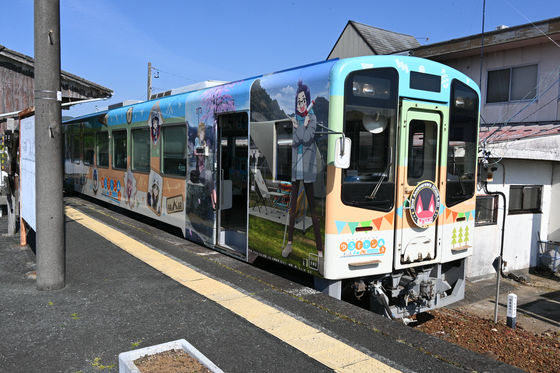
We arrived at Miyakoda Station, the station building of which won the Good Design Award in 2015.

There was a Nagisa Kaworu panel at '12 Miyakoda Station' inside the station building.

It matches well with the black painted interior of the station building.
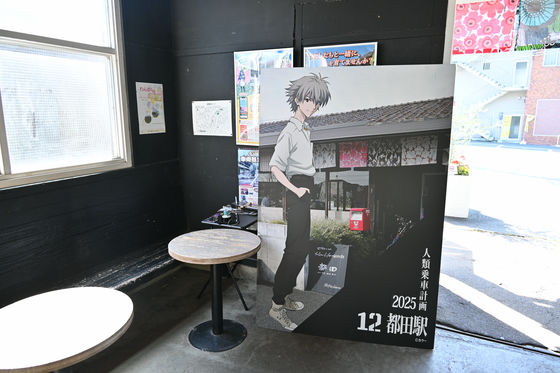
There is also
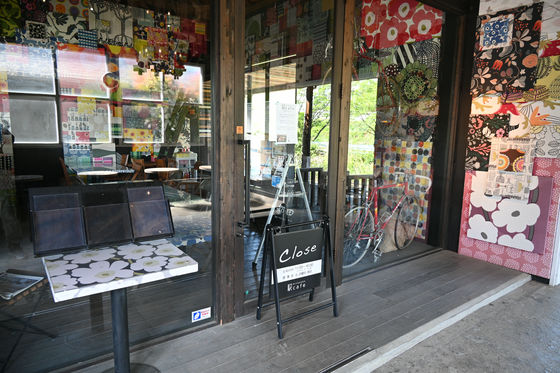
There is a bus stop opposite the station, where buses to Hamamatsu Station depart and arrive.
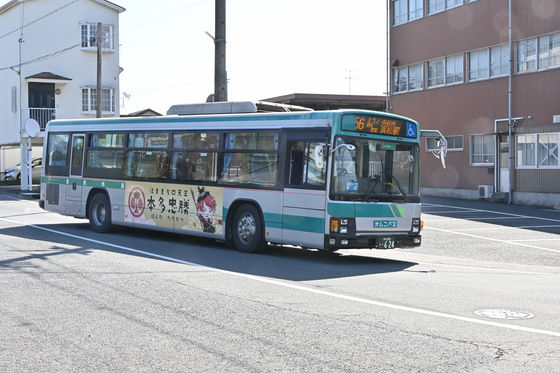
The exterior of the station looks like this. It is a renovated old station building.
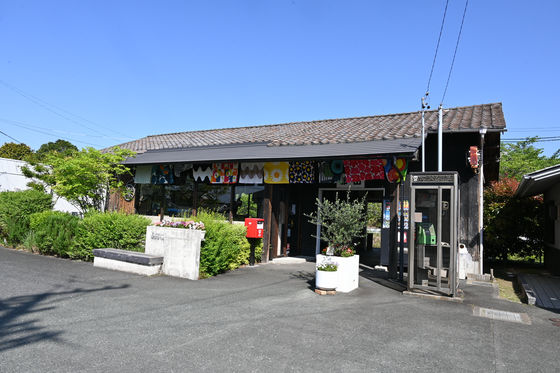
This time we head west again to Kanasashi Station.

From here, we head to
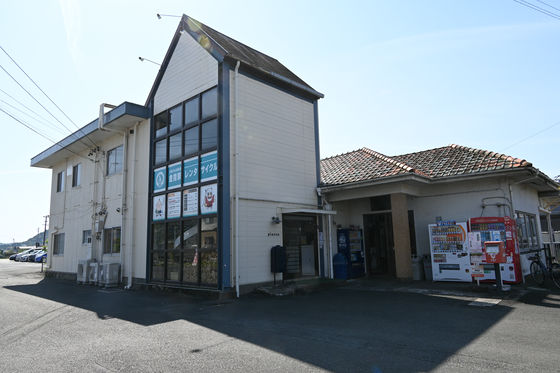
However, Iitani is like a valley, as the name suggests, and from Kanasashi we had to cross a mountain, so it took a lot of energy to ride a bicycle without an electric assist. I regretted that I should have accepted a little waiting time and taken the bus.
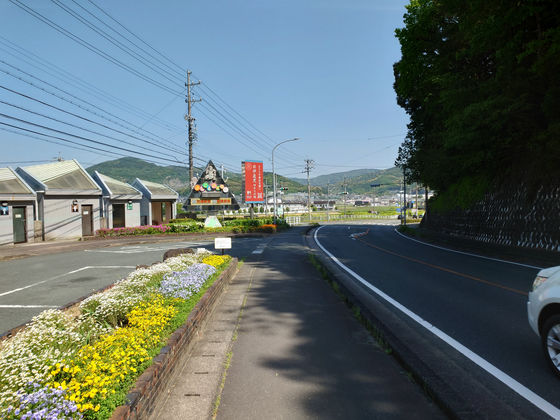
It was too late to regret it, so I just went ahead and arrived at Iitani.
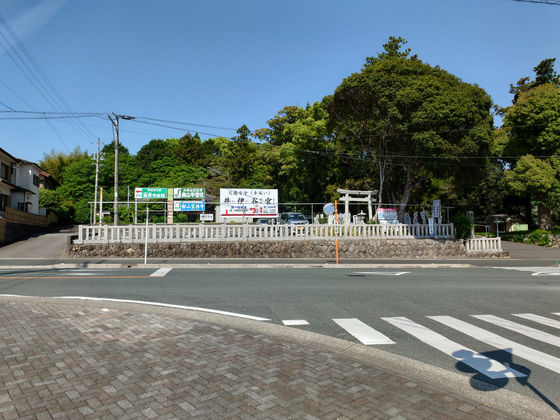
Head to Ryutanji Temple.

There is a stamp pad and panel near the toilets just before the entrance to Ryutanji Temple.

'19 Ryutanji Temple', Ritsuko's panel.
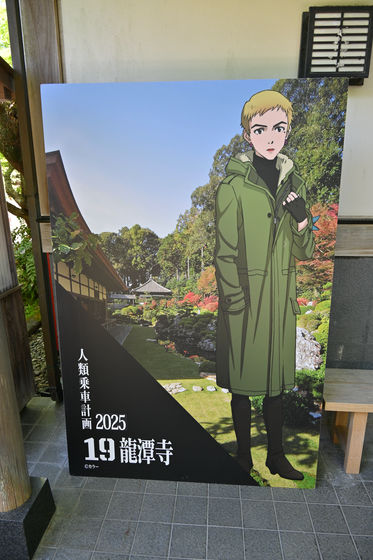
The garden is open from 9:00 to 16:30, and the admission fee is 500 yen for adults. The required time is about 60 minutes, so I decided not to visit the garden this time because I was heading to another place.
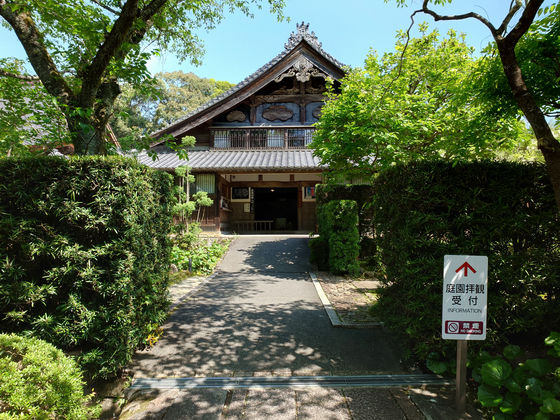
Heading northwest from Iitani is the limestone cave 'Ryugashiwa Cave.' Along the way, you will see information signs like this.
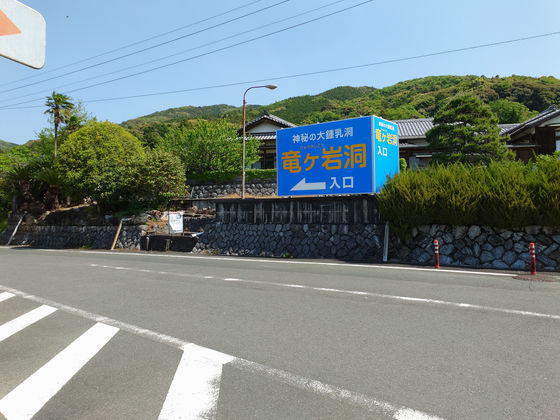
It took about 15 minutes from Ryutanji Temple to reach Ryugaiwa Cave. The road was slightly uphill, so I regretted taking the bus. Ryugaiwa Cave is open from 9:00 to 17:00, and the admission fee is 1000 yen for adults. However, I got a 10% discount because I had a 1-day free pass.

Ryugasaki Cave is the largest limestone cave in the Tokai region.

The total length is about 1 km, of which about 400 m is open to the public. The average temperature inside the cave is 18 degrees, so it feels cool in the summer and warm in the winter. This is 'Golden Fuji.'

After touring the inside of the cave, you will finally arrive at the Cave Museum.
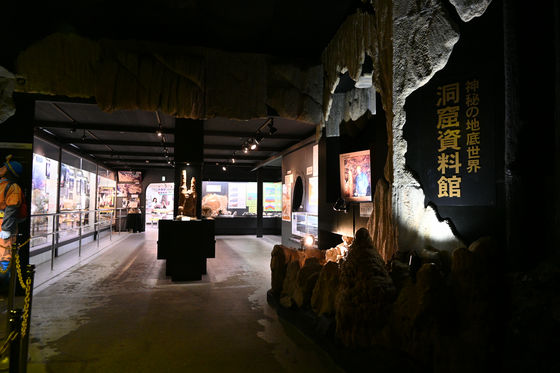
Just outside the museum, there is a Mari Panel for '18 Ryugasaki Cave.'
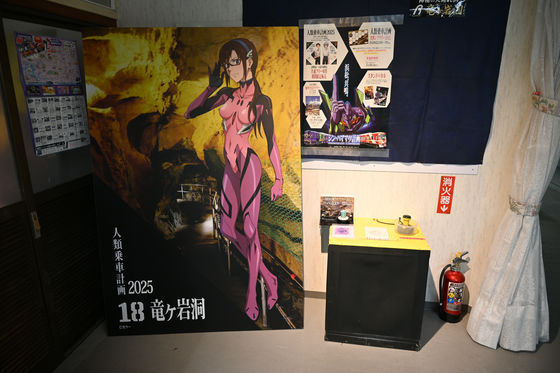
We were so tired from the bike ride that we stopped off at Materia, a gelato shop inside the convenience store.
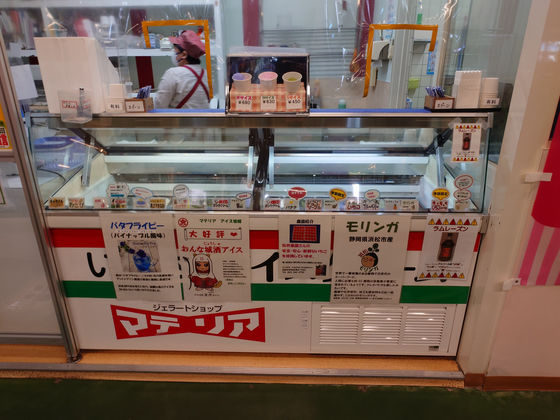
The ice cream comes in a cup and costs 450 yen for a small size, 630 yen for a medium size, and 680 yen for a double size that lets you have two flavors, so I decided to go for a double of 'Moringa' and 'Su.'
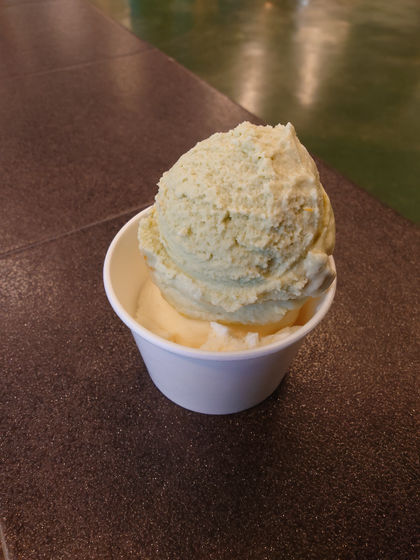
Feeling refreshed, I returned to Kanasashi Station by bicycle. It was easier now that there were more descents than uphills, but leaving Iitani was a steep uphill climb, and I found myself asking myself for the umpteenth time, 'Why did I choose to cycle?' The bicycle rental service is handled by the station staff at Kanasashi Station, so make sure you return the bicycle with plenty of time.

From Kanasashi, we head west again and arrive at Oku-Hamanako Station, a station quietly nestled on a hill behind a residential area.
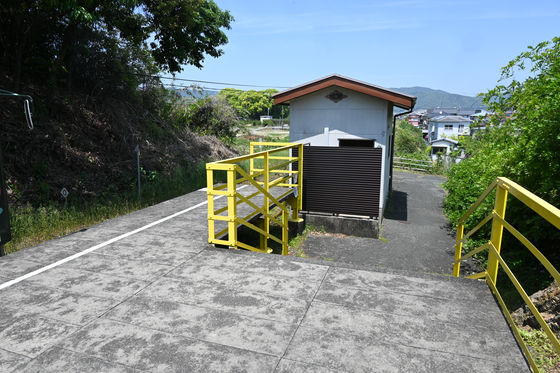
About a five minute walk away is
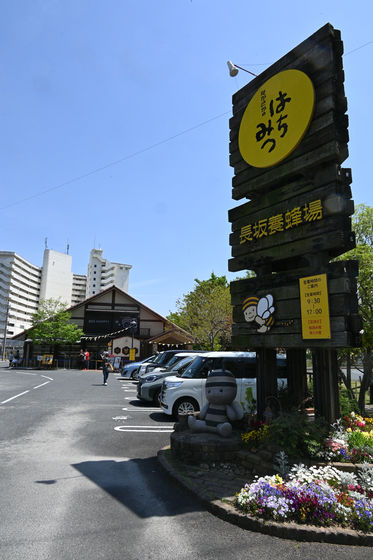
The store sells honey by weight, and you can also purchase sweets made with honey.

Although there is no eat-in space, they do sell soft serve ice cream made with honey. After the ice cream is ready, they will add more honey to it.

Perhaps it's because of the coldness of the soft serve ice cream, but the sweetness is light and refreshing, and it feels like it seeps into your body.
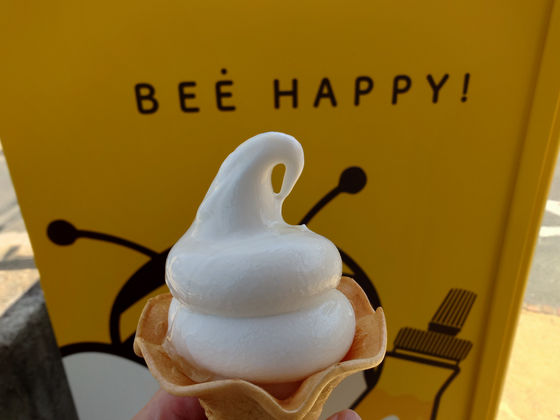
Honey and rusks are also sold in vending machines outside the store.
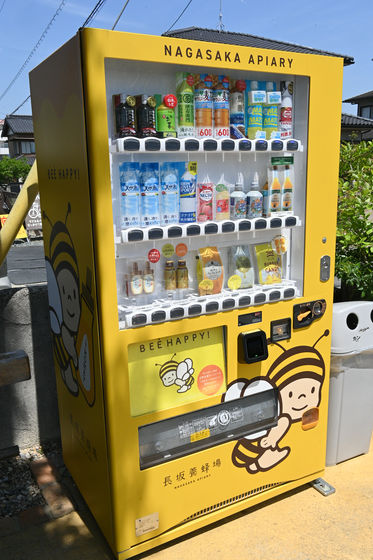
In this outdoor dining area, a panel depicting Kitakami Green from '20 Nagasaka Bee Farm' has been installed.
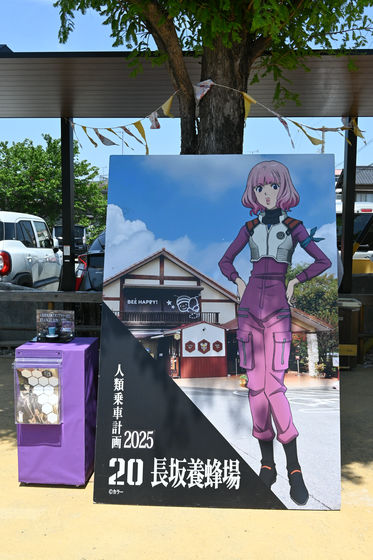
I returned to Oku-Hamanako Station. I didn't notice it when I got off, but the station is now known as 'The Town Where You Can Meet Bunbun' and is all about honey.
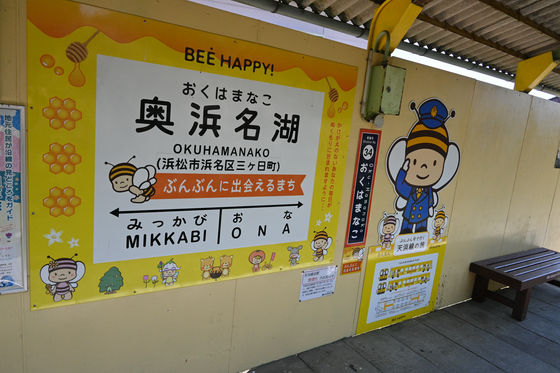
From here, we head back east towards Kakegawa for the first time in a while.
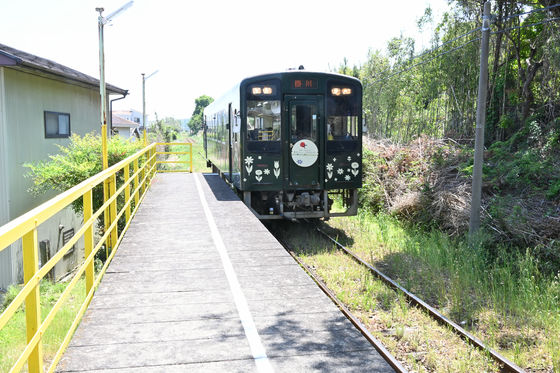
Arrived at Kiga Station.
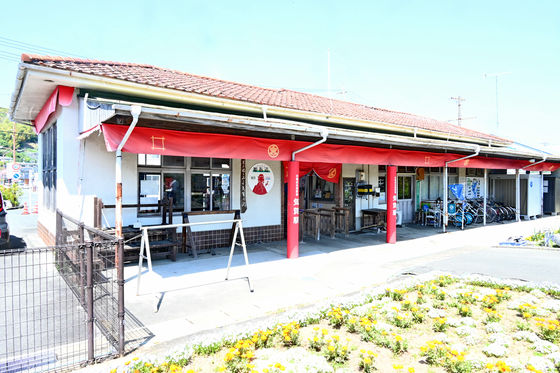
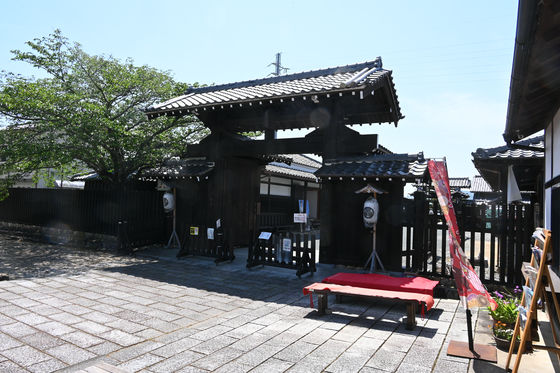
In front of the guardhouse, there is a panel of Shinji Anchor from '17 Kiga Barrier'. Does this mean Shinji will be interrogated...?
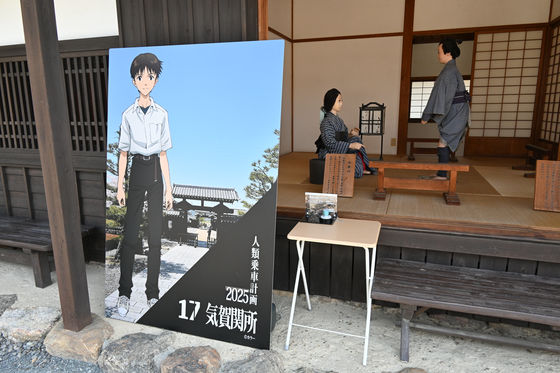
You can climb up to the Lookout Post inside the checkpoint.
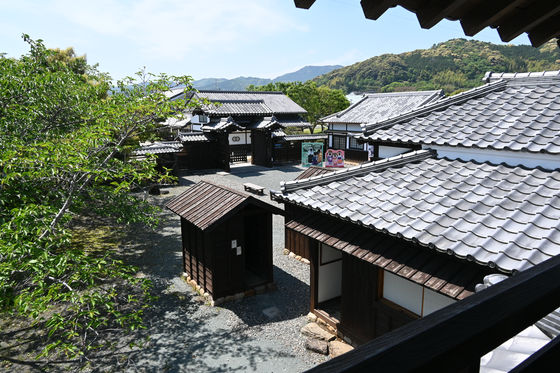
I returned to Kiga Station. There is a Chinese restaurant called

You can also board a bus to Hamamatsu Station from the bus stop on the north side of the station.
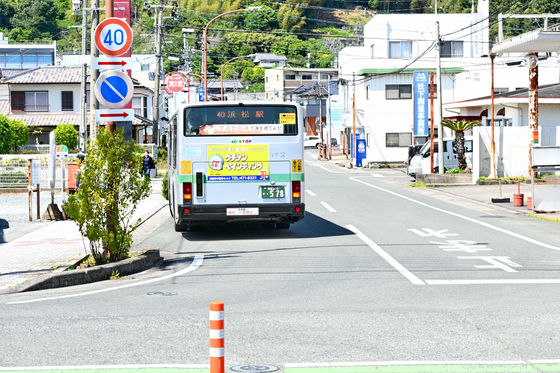
The inside of the station was themed around 'Yuru Camp△'.

Continue straight and you will arrive at the western terminus, Shinjohara. As you exit the station, you will see a Mari panel with '10 Shinjohara Station' written on it.
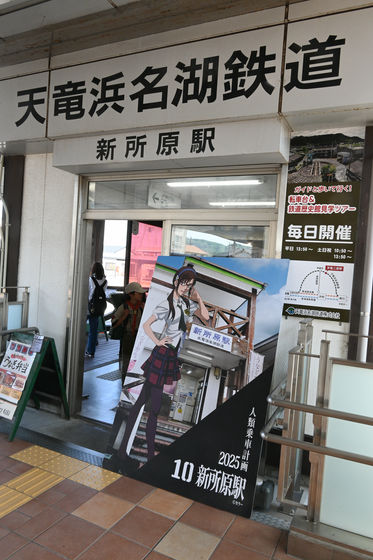
Shinjohara Station of the Tenryu Hamanako Railway, seen from the JR station corridor.
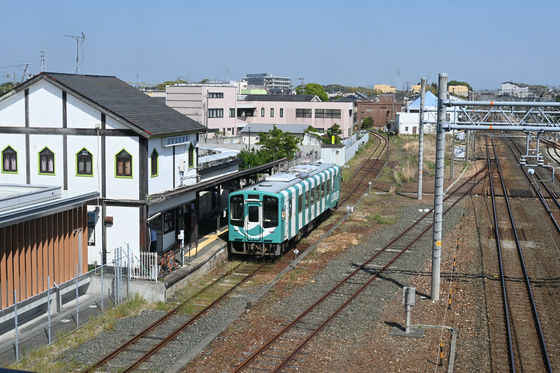
In addition, an Evangelion-wrapped train was parked near the JR platform.

This time, I collected all the stamps and visited 19 of the 21 stand panels, but I did not visit '13 Kunma Waterwheel Village' or '14 Tateyamadera Temple.'
Kunma Waterwheel Village is located quite far north in Tenryu Ward, Hamamatsu City, and the only way to get there by public transportation is to take the Tenryu Fureai Bus Atako Line from Nishikashima Station. However, this bus only runs on weekdays, the timetable is not designed for visiting Kunma Waterwheel Village, and I was not planning on using a rental car this time, so I quickly gave up on this idea.
On the other hand, it is possible to visit Tateyama-dera by bus from Hamamatsu Station, but I gave up because I was tired after traveling all day and the 50-minute bus ride one way was tough, and I knew that it would be impossible to visit 'Kunma Waterwheel Village' and complete the panels. If you have the energy, I recommend that you try to complete not only the stamps but also the stand panels.
Related Posts:


